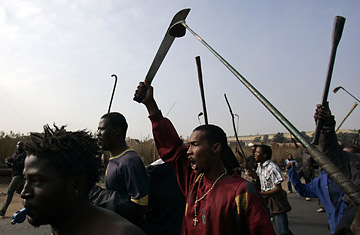
A mob chants in the Reiger Park settlement outside Johannesburg, South Africa, May 20, 2008.
President Thabo Mbeki on Wednesday ordered South Africa's army into black townships around Johannesburg for the first time since the apartheid era, hoping to quell anti-immigrant violence that has left 42 dead and 16,000 homeless. Fears that the violence was spreading to other cities appeared overstated, however, with a single mob attack on a foreign-owned bar in the Indian Ocean city of Durban quickly dispersed. But the country may already be counting the cost of a fortnight of mob killing, raping and burning — particularly images of mobs burning foreigners alive in the streets — that will haunt the international imagination for years.
South Africa is one of Africa's premier tourist destinations — with the industry accounting for around 8% of the country's GDP. Moeketsi Mosola, CEO of South Africa Tourism, on Tuesday acknowledged that the anti-immigrant attacks "place a very negative reputation on brand SA." Mosola reflected the widely held concerns over South Africa's status as host of the 2010 soccer World Cup when he added: "In the spirit of hosting Africa's first Fifa World Cup, it is of critical importance that we recognize that we are not an island, that we are bound together as Africans by history, culture and our ability to embrace people of all backgrounds." The negative effects on South African business won't be confined to the tourism industry: The rand has fallen more than 2% since Monday, and the victims of the mob violence included the owner of a South African construction company accused of hiring foreigners, who died when a crowd set fire to his house.
Those are the after-effects that are easier to calculate. More elusive is the damage to South Africa's national fabric. Archbishop Desmond Tutu's post-apartheid proclamation of a "Rainbow Nation" has long been recognized as more of an ambition than a reality. Even so, many South Africans, and the world — perhaps more accustomed to white-versus-black conflict in South Africa — have been shocked by the depth of black-on-black hatred revealed in recent days. "There is a chorus of disgust," wrote the Cape Argus in an editorial, "a consensus that it shames the country."
But as the daily noted, "this is only a start." One of post-apartheid South Africa's darker secrets is this: Nearly half a century of white supremacist rule didn't make racists only among whites. Despite the nominal end to racial discrimination — and one of the most liberal constitutions in the world — South Africa remains a divided country. Africa's wealthiest nation is segregated first by skin color, but also by ethnicity — English, Afrikaner, colored, Xhosa, Zulu, Sotho, Pedi, Shangaan, Indian, Chinese and, of course, foreigners. Not a year goes by without some group — in 2006 and 2005, it was Somalis, in Port Elizabeth and Cape Town — bearing the violent brunt of these darker sentiments. The past 11 days of violence are a cruel wake-up call. As the Argus wrote: "The urgent question is how best to convert this collective revulsion into formulating a lasting South African refugee policy, and short-term responses, so that fellow Africans in our country do not have to live in terror simply because they are strangers."
